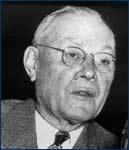 William Green was the second long-term president of the American Federation of Labor, serving from 1924 until his death in 1952. An advocate of labor-management cooperation, legislated wage and benefit protections and industrial unionism, he continued the federation's evolution (begun under its first president, Samuel Gompers) away from the "pure and simple unionism" of its origins and toward the more politically involved "social reform unionism" characteristic of mid-century.
William Green was the second long-term president of the American Federation of Labor, serving from 1924 until his death in 1952. An advocate of labor-management cooperation, legislated wage and benefit protections and industrial unionism, he continued the federation's evolution (begun under its first president, Samuel Gompers) away from the "pure and simple unionism" of its origins and toward the more politically involved "social reform unionism" characteristic of mid-century.
Born in Coshocton, Ohio, in 1873, into an English and Welsh immigrant coal-mining family, Green began working as an underground coal miner when he was 16. Three years later, he married Jennie Mobley, with whom he had six children. Green was elected secretary of the Coshocton Progressive Miners Union in 1891, which later became a local of the United Mine Workers of America (UMWA). He went on to serve as subdistrict president of the UMWA in 1900 and president of the Ohio district of the UMWA in 1906.
In 1910, Green campaigned successfully for a seat in the Ohio Senate, where he served as both Senate president pro tempore and Democratic floor leader. He was re-elected to a second term in 1912. As a state senator, Green wrote and won passage in 1911 of a model Workmen's Compensation Act. He also secured bills to limit the hours of women wage earners, establish a 1 percent income tax, elect Ohio's U.S. senators by popular vote and hold judicial elections on a nonpartisan basis.
Green's successes helped ensure his appointment as international statistician for the UMWA in 1911 and as UMWA international secretary-treasurer in 1913. He was named to the AFL Executive Council in 1914 as the UMWA representative and became the federation's secretary-treasurer in 1916. Green served as one of five labor delegates to the Paris Peace Conference at the end of World War I. Upon the death of Samuel Gompers in 1924, Green was the consensus choice for president of the AFL, a post he would hold for the next 28 turbulent years.
Under Green, the AFL in the 1920s shifted its strategy from confrontation to cooperation. Gompers generally had charted an independent, confrontational course for the federation during his years as its president, despite his membership in the National Civic Federation and his close association with the Wilson administration. Green preferred a more cooperative approach. He was at his best when seeking public support for legislation that would benefit all workers and when preaching cooperation with employers in the name of mutual self—interest and the common good.
Green preached union-management cooperation in the day-to-day operation of the workplace. He also advocated a reduction in the hours of labor, which he believed would increase the living standards of workers and create greater opportunities for civic participation. Finally, Green promoted a productivity-wage bargain (or voluntary incomes policy) between labor and management, tying higher wages for workers to productivity increases.
Each of these initiatives, he argued, would benefit both workers and employers—but few were listening in the 1920s. Nevertheless, something very much like his proposals was embraced by a new generation of labor and business leaders as the basis of post-World War II prosperity.
Green was an advocate of legislative action to secure workers' rights and benefits, and he helped ensure federation support for such legislation in the 1930s. Green's backing was crucial to winning passage of the 1932 Norris-La Guardia Act, which severely limited the use of injunctions in labor disputes and abolished so-called "yellow dog contracts" that required workers to agree not to join a union as a condition of employment. That same year, Green gained federation endorsement for a national unemployment insurance system funded primarily by employer contributions. He later helped pass the 1935 National Labor Relations Act, which strengthened workers' rights to organize and bargain collectively, and the Fair Labor Standards Act of 1938, the first federal law establishing minimum wages and a 40-hour week for all workers.
Green was also a consistent critic of the federation's reluctance to embrace industrial organization in mass production and sought ways to reconcile the competing claims of craft and industrial unionists. Although not always able to prevail against the entrenched craft interests on the AFL Executive Council, he did secure the board's support for issuing "federal union" charters to the many workers' groups seeking to organize on an industrial basis in the early 1930s. Many of these federal locals later led to new national unions that would emerge among mass production workers in the rubber, electrical, auto and other industries. When many of the industrial unions left the AFL to form the CIO, however, Green refused to support their action, insisting they had violated the cardinal principle of trade union unity by setting themselves up in opposition to their parent organization.
In 1933, President Franklin D. Roosevelt appointed Green to the Labor Advisory Council of the National Recovery Administration, and he later served on the 1934 National Labor Board, the forerunner of the National Labor Relations Board. During the Korean War, President Harry Truman appointed him to the National Advisory Committee on Mobilization.
During his later years as AFL president, Green's health began to fail and he let more and more of the day-to-day responsibility for running the AFL fall on the shoulders of his younger secretary-treasurer, George Meany. Green died at his home in Coshocton in 1952 after a long illness.

